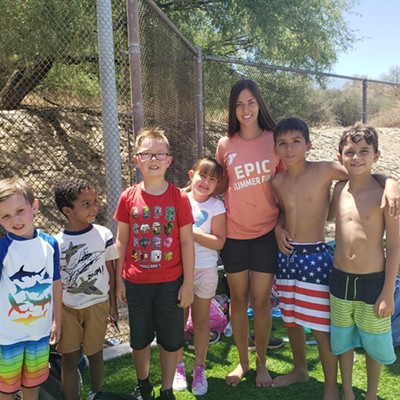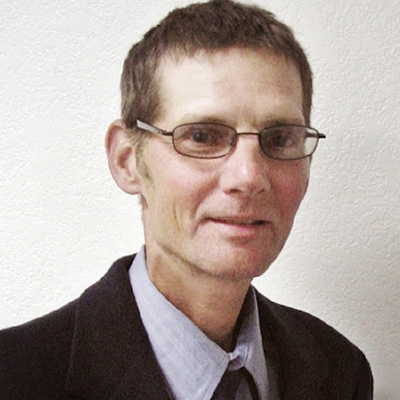Then consider that he wears two hats, as Santa Cruz County's interim emergency-management director and head of its health-services department.
Next come the doubts: If disaster strikes just across the line in Nogales, Sonora--an explosion, chemical spill or, God forbid, a pandemic--Irvine's not so sure Southern Arizona can halt a sudden wave of panicked Sonorans pouring north.
"If you have large numbers of people, as in thousands of people pushing in from that side," he says, "they could easily overwhelm the numbers of law-enforcement agencies on this side holding them back.
"Certainly, if the Border Patrol or Customs were to look at the reality of the situation, they don't have the numbers to adequately defend ... to keep people from coming across."
Not that it's necessarily terrifying to have Mexican citizens traveling north, considering that millions cross the Arizona border every year. But contemplate a sudden contagion in Sonora, and suddenly the magnitude of Irvine's concern becomes clear.
Not surprisingly, the folks from U.S. Department of Homeland Security--parent agency to Customs and Border Protection (which includes the Border Patrol) and Immigration and Customs Enforcement--don't exactly agree with his assessment.
"There are a number of contingencies we've addressed in our contingency planning," says DHS spokeswoman Amy Kudwa. "For security reasons, I'm not in a position to discuss those specific contingencies and how we would respond to them, and there's not a one-size-fits-all response. There are circumstances where people might potentially be allowed to cross, and others where they would not."
When pushed for an example of how DHS might intercede, Kudwa gets a bit touchy. "I'm not privy to CBP operation plans here at headquarters in Washington, D.C.," she says. "So let me reach out to CBP and get a little visibility on this, and then I'll circle back with you."
But Kudwa never did circle back after reaching out, so we called CBP ourselves. Spokeswoman Bonnie Arellano cites a national emergency-response policy, in place at every port from Texas to California. "It covers floods and fires," she says, "or some disaster that would effect a population migration for emergency."
At the same time, those plans "are very open-ended in their interpretation of how people would be processed. People with documents would be brought in with as much speed as possible, and those without documents would be detained in a gym or whatever. It would be different from port to port."
In turn, if the crisis involved a contagion, "we have a contact number with the U.S. Centers for Disease Control and Prevention in California. We have all of that in place."
Based on tabletop exercises that included Santa Cruz County, "I really feel confident that the ports of entry could handle a situation if it were to occur," Arellano says.
Nogales, Ariz., and its Mexican counterpart are also among 14 "sister cities" under the United States-Mexico Joint Contingency Plan, which is essentially a binational response protocol for fires, hazardous chemical spills or explosions.
In this state, federal funds to improve coordination between agencies are distributed by the Arizona Department of Homeland Security. "We manage about $140 million in active grants in a variety of programs that have specific functions," says spokeswoman Amy Bolton. That includes grants geared to "citizen preparedness in the event of a disaster. Those grants would go to local agencies and local governments to educate citizens."
However, Arizona still lags behind much of the nation in emergency-response capabilities. For instance, agencies often lack the ability to communicate by radio without requesting special equipment, and the state has a rather limited emergency-warning system. Not that much of the country is any better off. Speaking before Congress in 2007, Arizona Homeland Security Director Leesa Berens Morrison described a nation that "lacks a comprehensive, interoperable emergency-communications system, the absence of which makes it both dangerous and difficult for first responders to protect and save lives. In Arizona, we do not have to theorize about what our communications needs would be in an emergency situation--our first responders on the border operate under these conditions every day." On a more positive note, the United States, Canada and Mexico have reached broad cross-border agreements to contain the outbreak of infectious diseases. There's also the U.S.-Mexico Emergency Preparedness and Response Program, which conducts binational emergency response exercises.
But in the end, boots on the ground are what matter most. "We're very resourceful," says Arellano of the CBP. "We have a lot of tentacles out to local law enforcement, and to those local agencies who would able to assist us."
That includes Kevin Irvine's emergency-services department. "We do a whole host of things with a variety of agencies here," Irvine says, "from the local sheriff's office and the Nogales Police Department to all the various fire departments, Border Patrol and any other agencies that would play a part in responding to an emergency situation."
But he's not sure whether that plethora of manpower can guarantee a secure port, particularly in the case of "some very, very contagious disease that moved rapidly through the populace" in Nogales, Sonora.
Thousands rushing the port could quickly inundate even federal agencies such as the Border Patrol, he says. "And if they were overwhelmed, there's certainly not much we could do. And once (people) get across, then we're really out of luck, because they can move too rapidly for us to adjust to it. "
This is particularly true with a tangle of jurisdictions suddenly finding themselves on the same team. These authorities do conduct interagency emergency-response drills. But, for instance, responsibility for closing Interstate 19 would initially fall to the DPS, and then to the Arizona Department of Transportation. That's a lot of phone-calling for a situation that might unfold within minutes.
"It's one of those things we work out, and we try to think of the various possibilities of how you might be able to stem the tide," Irvine says, "how might you be able to divert people, to convince them to slow down rather than immediately heading for Tucson or Phoenix if they come across.
"But what do you do with thousands of people? And is it even possible to do anything to slow them down?"












